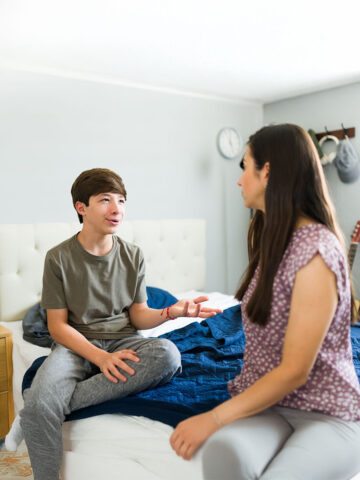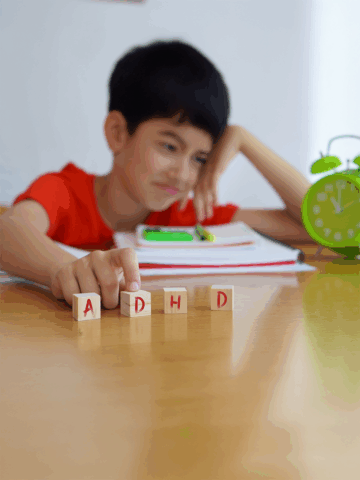Many families may be hearing kids, teens and adults with depression or anxiety disorders being referred to as “high-functioning.” As described in media outlets, social media and throughout communities, “high-functioning depression” or “high-functioning anxiety” describes an individual that can complete their daily tasks, appear put together or carry a positive attitude while struggling with anxiety or depression internally.
However, Baleska Alfaro, a licensed marriage and family therapist at CHOC’s Co-Occurring Clinic, warns that there are some problems with labeling kids or teens as having high-functioning depression or high-functioning anxiety.
Here, she debunks the myth of the term high-functioning when describing depression and anxiety, and how parents can help reduce stigmas surrounding mental health challenges.
What exactly is high-functioning depression and high-functioning anxiety?
Although the phrases high-functioning anxiety and high-functioning depression have gained popularity in recent years, neither is a clinical diagnosis. If fact, the term is not included in the Diagnostic and Statistical Manual of Mental Disorders (DSM-5), which is the manual that clinicians use to diagnose and explain mental health disorders to patients.
“High-functioning is a colloquial term that can be misleading,” says Baleska. “I only use language that is in our DSM-5 to explain a diagnosis to patients so that they have a clear understanding of their mental health symptoms and so that the diagnosis is not misinterpreted by the patient, their family and/or friends.”
High-functioning depression is an unofficial term that is used to reference a child, teen or adult who experiences bouts of depressive symptoms that either do not or only mildly interrupt their day-to-day life.
Persistent depressive disorder, which some may define as chronic depression, is a milder type of depression that develops more gradually and may last for two years or longer. This type of mood disorder may be labeled as high-functioning depression informally by communities because its symptoms do not always appear to impede day-to-day functioning.
Similarly, kids, teens and adults who have mild anxiety symptoms, such as worried thoughts about the future and challenges controlling such worries, may be labeled as having high-functioning anxiety because they may be seen as thriving externally despite their internal challenges with managing their anxiety symptoms.
Why is it misleading to describe depression or anxiety as ‘high-functioning’?
It’s common for depression and anxiety symptoms to change in intensity and/or frequency depending on many factors like external psychosocial stressors or the use of medications, says Baleska. Using a term like high-functioning can lead people to believe that their depression or anxiety cannot shift or change in intensity or frequency when it certainly can.
This colloquial term can also contribute to patients, families and communities believing that mental health conditions like anxiety or depression will not interfere with a person’s daily life because their condition is high-functioning. So, if a child or teen believes that they have high-functioning anxiety or depression and their symptoms begin to worsen, that belief may prevent them from seeking help or create shame about their sudden inability to carry out those day-to-day tasks they used to be able to do.
The term can perpetuate a false narrative that because the depressive disorder or anxiety is high-functioning, the symptoms are “not that bad” and do not warrant monitoring, says Baleska. It may also convince kids and teens that they do not need to or should not seek mental health services to cope.
In addition, labeling some kids and teens with depression or anxiety as high-functioning may be harmful to other kids that are struggling with the same disorders. They may feel like their peers who are high-functioning have more power over their symptoms than them, which can perpetuate a harmful stigma around mental health.
What are the symptoms of depression?
The DSM-5 recognizes the following depressive disorders. Each has varying symptoms with variable intensity and frequency of said symptoms:
- Major depressive disorder. Major depressive disorder is an intense episode of depressive-like symptoms, such as sad or irritable mood, loss of interest in engaging in pleasurable activities, changes in eating and sleeping patterns and/or fatigue, that has recently developed and has lasted for at least 2 weeks.
- Persistent depressive disorder (chronic depression). Chronic depression is a milder depression that has developed more gradually and has lasted for 2 years or longer. This kind of depression can be referred to as the colloquial term, “high-functioning depression.”
- Adjustment disorder with depressed mood. Adjustment disorder is depression that has developed within three months of an identifiable stressor (anything from a natural disaster to a death in the family). This condition will usually subside within six months of the stressor no longer being present.
- Disruptive mood dysregulation disorder. This type of depressive disorder is a pattern of intense, frequent temper tantrums, outbursts of aggression and anger and a usual mood of irritability that has lasted for at least a year in a child older than 6 years.
- Premenstrual dysphoric disorder. This depressed mood occurs in the majority of a person’s menstrual cycles. The sad or irritable mood begins the final week before a menses and usually subsides in the week after a menstrual cycle.
If a child or teen is depressed, parents may notice the following symptoms:
- Sad or irritable moods. A child may seem sad, lonely, unhappy or grouchy. It can last weeks or months. A child may cry more easily. They may have more tantrums than before.
- Self-criticism and expressed negative thinking. Kids going through depression may complain a lot. They may say self-critical things like, “I can’t do anything right.” “I don’t have any friends.” “I can’t do this.” “It’s too hard for me.”
- Lack of energy and effort. Depression can drain a child’s energy. They might put less effort into school than before. Even doing little tasks can feel like too much effort. Kids may seem tired, give up easily or not try.
- Lack of enjoyment. Kids don’t have as much fun with friends or enjoy playing like before. They may not feel like doing things they used to enjoy.
- Sleep and eating changes. Kids may not sleep well or seem tired even if they get enough sleep. Some may not feel like eating. Others may overeat.
- Aches and pains. Some children may have stomach aches or other pains. Some miss school days because of not feeling well, even though they aren’t sick.
What are the symptoms of anxiety?
The DSM-5 recognizes the following anxiety disorders. Similar to depressive disorders, each anxiety disorder has varying symptoms that may fluctuate in severity over time:
- Generalized anxiety disorder (GAD). With GAD, children have many worries and worry much of the time. They may also have physical symptoms, like headaches, stomachaches, muscle tension, or tiredness.
- Phobias. A phobia is an intense, unrealistic fear of a specific thing. Some kids have a phobia of dogs. Others have a phobia of spiders or snakes. A child with a phobia will go to great lengths to avoid the thing they fear.
- Social anxiety. Kids and teens with social phobia have an intense fear of being judged. It affects them in social or other situations. They will avoid situations where they may have to meet new people or perform.
- Selective mutism. Some students are too fearful to talk at all in certain situations. Kids and teens with selective mutism are able to talk and talk well. But they are too fearful to talk in some situations outside their home or with people other than friends.
- Panic disorder. Some students have panic attacks, a sudden and intense episode of fear. They can include physical symptoms like a pounding heart, shortness of breath, or dizziness. Panic attacks can happen unexpectedly.
- Separation anxiety. It’s normal for babies and very young children to have some separation anxiety when they are apart from a parent or caregiver. But when separation anxiety lasts beyond the early school-age years, students may have trouble coming to school.
- Agoraphobia. A type of anxiety disorder in which kids and teens may fear and avoid places or situations that might cause them to panic and make them feel trapped, helpless or embarrassed.
Children or teens with anxiety disorders may experience different symptoms than adults would. Unlike adults with anxiety, children and teens often don’t realize that their anxiety is more intense than the situation calls for.
Symptoms may be a bit different for each child. But the most common symptoms of anxiety are:
- Many worries about things before they happen.
- Many worries about friends, school or activities.
- Almost constant thoughts and fears about the child’s safety or the parents’ safety.
- Refusing to go to school.
- Frequent stomachaches, headaches or other physical complaints.
- Muscle aches or tension.
- Sleep problems.
- Lots of worry about sleeping away from home.
- Clingy behavior with family members.
- Feeling as though there is a lump in the throat.
- Extreme tiredness (fatigue).
- Lack of concentration.
- Being easily startled.
- Being grouchy or irritated.
- Inability to relax.
The symptoms of anxiety may seem like other health problems. Make sure your child sees their healthcare provider for a diagnosis.
How can parents reduce the stigma around mental health challenges for their kids?
Parents can have an enormous impact in reducing the stigma surrounding mental health by dismantling myths and providing factual information about mental health conditions to their children. To do this, it’s important for parents to be informed with accurate, reliable information from professionals. They can seek advice from resources like National Alliance on Mental Illness (NAMI), Substance Abuse and Mental Health Services Administration (SAMHSA), Orange County Health Care Agency or CHOC mental health education and services.
Once parents are equipped with accurate information, they can talk to their kids about mental health conditions and how they may impact their life or the lives of others. Parents should be open and honest, using respectful language about mental health disorders and people who have them. They should explain to their kids that symptoms of mental health disorders can ebb and flow, and explain why terms like high-functioning can be harmful.
Learn more about reducing mental health stigmas from CHOC experts. A CHOC pediatric neuropsychologist offers 5 practical ways to help reduce stigma around mental illness and a CHOC pediatric psychologist helps parents understand the role of cultural stigma on seeking mental health services.
How can parents help their kids that may be struggling with depression and/or anxiety?
If you think your teen might be depressed or have anxiety:
- Talk with them. Show extra love and support. Let them know you care and want to hear what they are going through. When they are depressed or anxious, many kids and teens feel alone, distant, or unlovable. Small gestures of caring can help them feel less alone.
- Take them to see their doctor. Set up a visit with your teen’s doctor or a mental health provider to check for depression or anxiety. Medical providers also can check for other health or mental health issues that might be causing your child’s symptoms. They can explain what they (and you) can do to help your child.
- Normalize getting help! If your child is experiencing symptoms of depression or anxiety, help them understand that mental health services could really help them manage or alleviate their symptoms. Encourage exploration of mental health services available to them such as therapy, support groups or psychiatric services.
Get more expert health advice delivered to your inbox monthly by subscribing to the KidsHealth newsletter here.
Get mental health resources from CHOC pediatric experts
The mental health team at CHOC curated the following resources on mental health topics common to kids and teens, such as depression, anxiety, suicide prevention and more.





